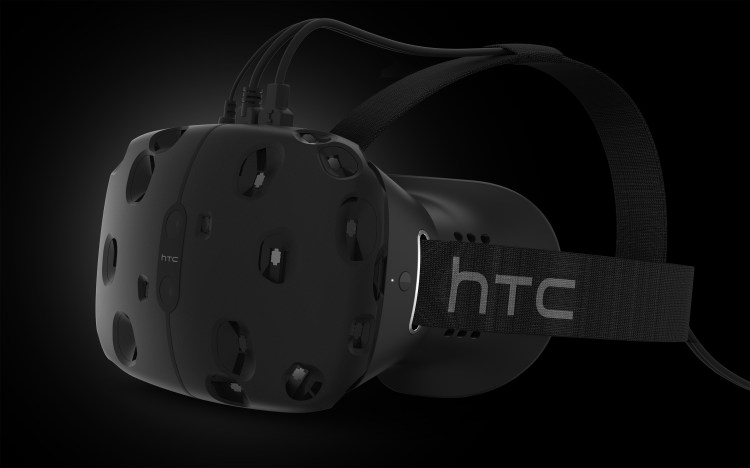Click here for all of GamesBeat’s 2015 Game Developers Conference coverage.
SAN FRANCISCO — I’m looking over the edge of a derelict sea vessel. It’s lying on the ocean floor, and I’m standing on its deck as sea life swims around me. As I look long into the abyss and feel vertigo begin to grip me, the voice of the Valve employee running the demo tells me to look left. I have to duck as a humpback whale swims up to me.
This is Vive.
It’s the first product to take advantage of Valve’s Steam VR platform from one of its partners — HTC, in this case — and it’s incredible. Like Oculus Rift or Sony’s Project Morpheus, Vive is a device that you strap to your face. It’s packed with sensors and all kinds of other gizmos to help the game software track your motion and movement. This is essential for Valve’s version of VR because the company doesn’t really want you stuck in a chair to experience simulated worlds. Instead, it said it has worked hard so that you can stand up and walk around your room without bumping into walls. This makes it possible for you to interact with different parts of a virtual room, and it was a big part of what made the experience so astounding.
In addition to the underwater scene, I also went through several other demos from Valve and its development partners today at the Game Developers Conference 2015. One was a kitchen simulator where I got to make soup. Another had me standing and walking around an ancient open elevator as a rock monster taunted me. And another one, which Valve built, put me in the world of Portal.
In all of these demos, I had the freedom to walk around and look at things. A key part of Valve’s technology that makes it possible to strut about without running into walls is something that company calls “Chaperone.” This is a system of laser beacons that sit around your room that inform the computer how big a space you are playing in. As I approached a real-world wall that I could not see at all, the in-game space would create a guiding grid to tell me I was getting dangerously close to stubbing my toe.
It worked well — although it wasn’t perfect, as I picked up a virtual item and tried to throw it only to feel my hand hit the wall that I didn’t know was there.
The controllers
Speaking of picking up and throwing things, one of the biggest innovations Valve has made is with its controllers. Instead of using an Xbox 360-style joypad, the company has designed a pair of sticks that you hold in each hand. They look like tiny little radar receivers — or maybe they don’t. I actually only remember what they appear as in the virtual world. But that’s not really important. What is in important is that the devices were able to track so that I could look down with the headset on and see my hands.
To enable me to interact with the world, the controllers feature a number of inputs. On the back, you have a trigger button. On each side, it has big paddles that you can squeeze with your palms. And then, most important, each one has a touchpad.
All of this was great for letting me pick up a candle that I threw at the aforementioned rock monster, but it was also incredible for the painting program. In this app, I used my controllers to draw in 3D space and in every direction. It was more like building an interactive sculpture than painting. I’m still reeling from it.
The controllers made the painting process simple. I could swipe on my left controller to bring up the color swatch and then poke my brush (the right controller) into it to choose precisely the shade I want. Choosing a different tool worked the same way.
The painting was a highlight, and I realized as it was happening that it is because it is showing all the strengths of VR and of Valve. It is interactive and creative, but it also reveals the correct way to design a simulated interface.
Lost in the simulation
My time with Vive ended with an original Valve creation. It was a narrative experience where I was in a lab. I had to open drawers and try to repair one of the Portal 2 robots while GlaDOS, the evil A.I. from that series, berated and humiliated me.
This was the last of five back-to-back demos Valve had shown me without ever taking the headset off. At this point, I was completely comfortable walking around. I hadn’t seen the room I was really in for about 15 minutes, but that didn’t matter. I trusted that the virtual space I was seeing was representative of the room I had to work in. If I ever got too bold, the Chaperone system would gently remind me of my boundaries.
At no point did I feel nauseous, and I often forgot that what I was looking at wasn’t real.
The Vive’s high-def, 1200-by-1080 display is sufficient once you start moving around. The pixels that are blatantly noticeable when you’re staring at a static title screen (or the HTC logo, for example) mostly fade away when you’re whipping your head back and forth to catch every little detail. And the 90 frames-per-second refresh rate was also fine.
What HTC and Valve have packed into the headset they showed me today will work as a consumer product. I’d buy this. I’m no longer worried about the tracking or the “screen door effect” on the display, because I felt present in Vive.
But let’s get back to that whale.
After ducking to keep it from knocking me over, I looked back up to see it stopped right in front of me. After looking over the giant beast, we looked into each other’s eyes. It blinked at me to say hello, and I — unable to help myself — blinked back. It was a moment I shared with something that never existed.
The foreseeable problems
Coming out of the demonstration, two things worry me about the potential for Vive or any potential Steam VR device.
The first issue is the cords. During my trial with the prototype, I wore a belt to keep a bundle of cords out of my way — and now that I think about it, Valve must’ve had someone walking around with me to make sure I didn’t trip over any slack that I created as I moved around the room.
The final version will only have one cord coming out of it, according to Valve, but that’s still troublesome. I don’t like the idea of stumbling around blind with the potential for a cord to trip me.
That also leads into my second concern. If Steam VR is really about standing up and walking around — and even if the Valve technology is perfect at tracking your space — how is it going to handle a tiny toy sitting in your play space. Or how about a rogue puppy? Is the system going to shut down with a big warning message that “a foreign object is in the space” every time your cat comes wandering in looking for attention?
Having a dedicated clean room dedicated to your VR hobby seems like a good way to limit the potential market, which I know is something Valve and its partners do not want.
Launching in 2015
Virtual reality definitely feels inescapable and inevitable at this Game Developers Conference. That’s exciting and a little frustrating since it’s my job to figure out a way to describe something so ineffable.
But I’m into the Vive — and, in a larger way, I’m into the way Valve is approaching virtual reality. While a company like Oculus is meticulously obsessing over every detail of its Rift headset, Valve is charging ahead with an open system that any hardware company can jump on.
If the Vive is the equivalent of the first-gen Android phone (which HTC was also responsible for), then I’m excited to see where we are in one to two years.
VentureBeat's mission is to be a digital town square for technical decision-makers to gain knowledge about transformative enterprise technology and transact. Learn More


